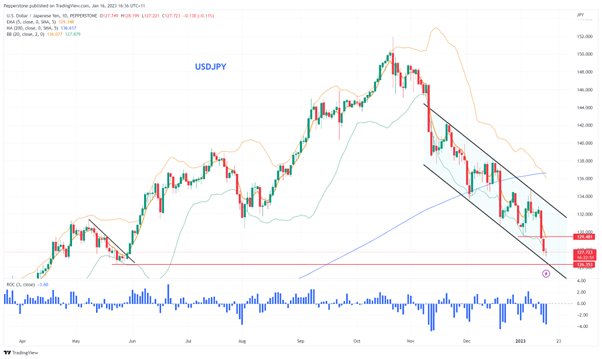- English
- 中文版
The BoJ meeting playbook - the potential for massive movement in the JPY and broad markets

The risk manager
The job of the trader is to manage risk, as well as achieving correct position sizing for every trade.
So, when I look at the explosion in USDJPY 1-week (options) implied volatility – essentially the markets' expectation of movement in USDJPY through the week – we see this at 23%, and the highest levels since March 2020.For context, this equates to expectations of around 350 pips, or a near 3% move this week in USDJPY (higher or lower). Much of this move could be realised on the day from headlines from the BoJ meeting and what the market hears relative to positioning and expectations.
When we see such high expectations of movement, the question traders need to ask is whether they should reduce or even exit exposures before the event. In some cases when there is a strong skew in the potential outcomes and a high enough conviction, whether to even take a position over the event – in special situations these events can offer high/risk reward outcomes.
We assess that here.
Key times to be aware of – Headlines and the outcome from the meeting will come out on Wednesday, likely in the Asia session afternoon. Unlike most data points there is no set time, but we should hear the outcome between 13:00 and 15:00 AEDT.
What is expected from the BoJ?
Last week we saw an article in the Japanese publication Yomiuri Shimbun that the BoJ was reviewing the negative effects of its current monetary policy regime – despite only changing its policy setting on 20 December, where they lifted the ceiling (or cap) by which the 10yr JGB yield (Japanese govt bond) can trade to 0.50%, the market swiftly took this to mean another key change was incoming.
The fact the BoJ had to ramp up its daily bond buying to a record amount to defend the 0.50% cap, suggests their policy setting is still highly dysfunctional, and with inflation pushing 4% its current yield curve control (YCC) program is on borrowed time.
While we can look at the possible outcomes, and assign a probability and potential market reaction, I think in all cases the BoJ will try its utmost to say the action is designed to address an increasingly dysfunctional market and should not be seen as a tightening of policy. The market will likely look through this and ignore their pleas.
Given 10yr JGBs currently trade above 0.5% (or 50bp), 10yr swap rates trade above 90bp and the JPY has had a one-way move of late, one assumes the market is skewed and part positioned to an outcome that the BoJ abolish its YCC program. This plays into my back-of-the-envelope playbook.

Possible actions:
- The BoJ again widens the yield band to -/+0.75% while continuing to buy incredible amounts of JGBs in its daily operations to support the 0.75% yield cap - an action that doesn’t make a huge amount of sense as it would not resolve the dysfunctional market and would need to be altered again –
- The BoJ widens the yield band out to -/+1% while continuing to buy JGBs to support the cap – tactically this makes more sense, but an action that could
- The BoJ leave policy unchanged but signals a change is coming – this would surprise and
- Completely terminates its YCC program – the market is leaning this way but would still likely
- Shifts the YCC target which is currently capping 10yr JGBs at 0.50% and move to target the 5yr JGB instead – it's hard to create a clear framework on this policy change, but an action that likely leads to
For those new to BoJ policy and bond markets this event risk does require some research. As always, moves in markets come from current market positioning, expectations, and the actual outcome.
For me, simplistically, given expectations are now elevated for an end to YCC and its yield cap – hence, a lack of action would be a big surprise and cause a significant move higher in USDJPY. If the BoJ decides to remove its YCC cap, then despite positioning I think there is further to go, and it could have huge implications for the JPY and see USDJPY smashed as traders front-run the idea of massive capital repatriation from Japanese pension funds eyeing more compelling returns in their domestic bond markets.
The BoJ meeting holds the potential for bug moves not just in the JPY and JPN225 but could influence the USD across other G10 pairs too – be aware of the event and manage the risks accordingly.
Related articles
The material provided here has not been prepared in accordance with legal requirements designed to promote the independence of investment research and as such is considered to be a marketing communication. Whilst it is not subject to any prohibition on dealing ahead of the dissemination of investment research we will not seek to take any advantage before providing it to our clients. Pepperstone doesn’t represent that the material provided here is accurate, current or complete, and therefore shouldn’t be relied upon as such. The information, whether from a third party or not, isn’t to be considered as a recommendation; or an offer to buy or sell; or the solicitation of an offer to buy or sell any security, financial product or instrument; or to participate in any particular trading strategy. It does not take into account readers’ financial situation or investment objectives. We advise any readers of this content to seek their own advice. Without the approval of Pepperstone, reproduction or redistribution of this information isn’t permitted.

